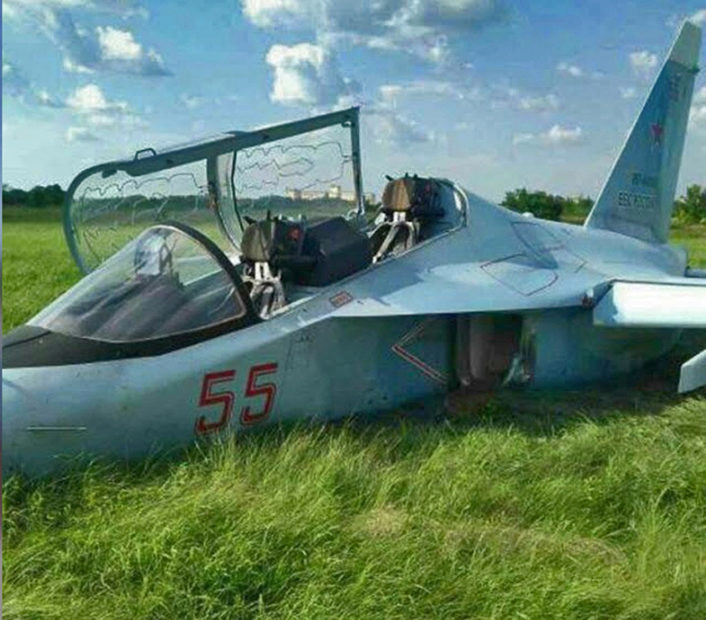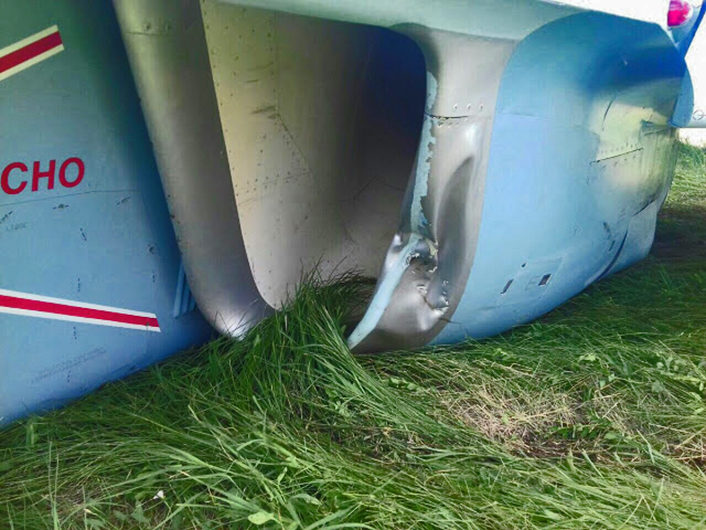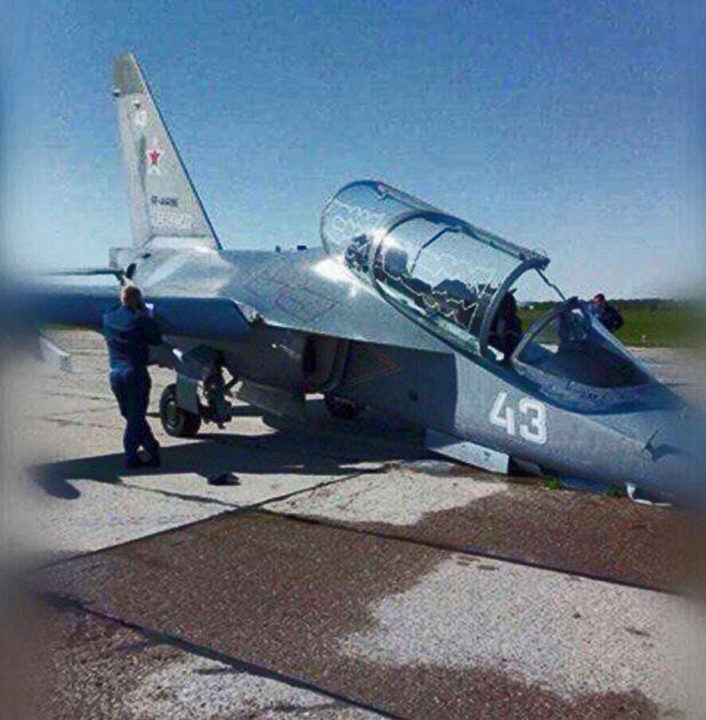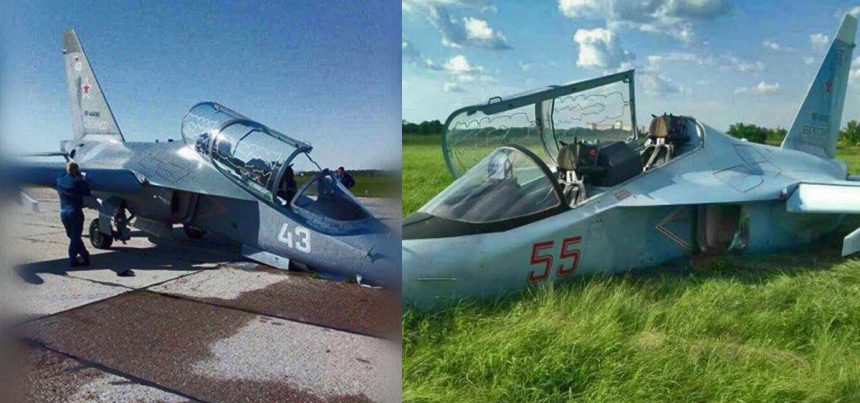Two Yak-130 Jets Have Crashed Simultaneously in Armavir and Borisoglebsk Last Month. And Here’s An Investigation On The Root Causes.
According to several reports, two Russian Air Force Yak-130 Trainer/Light Attack (LA) Aircraft (Tail number 43white/RF-44496 from Borisoglebsk airbase and 55red/RF-44583 from Armavir) crashed almost simultaneously in two different places on Wednesday June 21, 2017. Information about incident has not released by the RuAF (Russian Air Force).
The Yakovlev Yak-130 is a subsonic two-seat advanced trainer originally developed by Yakovlev and Aermacchi (now Leonardo).
Along with the advanced jet trainer role, the “Mitten” (Yak-130 NATO’s nickname), able to replicate the characteristics of Russian Gen. 4 and 4++ combat aircraft, is capable of fulfill Light Attack (LA) and Reconnaissance tasks and it can carry a payload of 3,000 kilograms, including guided and unguided weapons, external fuel tanks and electronic pods.
The LA version, dubbed YAK-131 and equipped with mechanical radar (Phazotron) or Passive Electronically Scanned Array (PESA), is planned to replace the Su-25 Frogfoot.The Russian Air Force has also developed a reconnaissance variant of the Mitten, dubbed Yak-133.
The Yak-130 bears a significant resemblance with Italian M-346 “Master”, produced by Leonardo Company and already operated by the ItAF (Italian Air force), IAF (Israeli Air Force), RSAF (republic Singapore Air Force) and Polish Air Force. This Author has been one of the first pilots and IP (Instructor Pilot) on the Italian T-346 (ItAF designation of the baseline M-346).
At the moment, the RuAF has not given any official information about the dual accident and the possible causes are still under investigation. However, local sources reported the first crash occurred during a normal flying training and has involved the Yak-130 (55 red/RF-44583) that belong to the Armavir Flying School.
Soon after the first crash, a second Yak-130 (43 white/RF-44496) belonging to the Borisoglebsk Air Force Base was forced to land on the runway.
INVESTIGATION ON GEAR UP LANDING. (55 red/RF-44583 Armavir)
In my career as a combat pilot, I’ve had the opportunity to undertake many different training courses. One of those was the Flight Safety Office (FSO) which include the investigation section with a simulated crash to “solve.”
By means of the methodology and approach used to investigate real incidents I’ll drive you in a very simple and basic investigation. We will analyze all the available details and see whether it is possible to determine the causes of these crashes.


First of all, what we can do is a “picture analysis” and looking at the picture of 55 red/RF-44583 you can notice some of important details useful to understand the landing or crash dynamics:
- The aircraft landed on the belly without any other damage or structural breaks: this means the aircraft touched the ground with a correct and normal attitude used during a normal landing. Therefore, we can assume the pilot “planned” to land on the grass;
- The aircraft had the LEF (Leading Edge Flap) in down position: this means the pilot lowered the LEF with the intent to land like he was on the runway;
- The canopy seems to be open in a normal way (no damage or glass rupture): in other words the two pilots abandoned the aircraft “normally” soon after the jet stopped. This detail suggests the pilot purposely landed there and did a soft touch down with no other consequence;
- Looking at the air intake, you can see the internal section extremely clean without any FOD: this means the engine was not running and it didn’t suck anything. One possible reason is a flame out or the pilot decided to shut down the engine seconds before the touchdown to avoid any fire.
After a FIR (First Impression Report), the second step is to merge all the above consideration in order to elaborate a possible scenario. Based on the above points, the two pilots most probably attempted an emergency landing with one or both engines not operating.
Now let’s move to the possible causes that forced the Yak-130 to land out of the runway and let’s try to understand WHY the pilot did take the decision to land on grass field.
First consideration is that the emergency was TIME CRITICAL, otherwise they could have enough time to fly and steer toward a suitable airfield. Based on my experience the most important hint comes from the picture of the air intake: this picture seems to suggest engines or thrust problems that forced the pilot to perform a forced landing out of the runway. Let’s explore possible reasons:
- The aircraft was completely out of fuel. This situation seems quite unlikely, almost impossible, unless aircraft showed false fuel indications (a case of multiple emergencies, that is to say fuel transfer failure combined with false fuel indication) because pilots use to plan the fuel required for all training tasks: the fuel to recovery to the base with enough fuel in case they need or to practice some visual pattern; and the fuel to divert to the alternate in case of problem with the home base;
- The aircraft had a fuel transfer failure and the crew suddenly found to have less fuel available to return home or to the nearest suitable airfield;
- The aircraft had a double engine flame out (this option can be also caused by the point 1 and 2) and the pilots were forced to find a suitable “strip” to land.
Of course I don’t know the RuAF SOP (Standard Operations Procedures) and the YAK-130 emergency check list procedures for the above emergencies.
In case of double engine flame out, due to fuel or engines malfunction, most of the military aircraft procedures require the pilots to eject unless they can safely recover or land the aircraft. Landing on the grass without gear is not a safe recovery but in this case (I want to remember that we don’t know too many details about the reason of crash and we are conducting an investigation based on a picture) pilots took a very brave decision and the option to land without landing gear was in the end a smart decision to soften as much as possible the touchdown on an “unprepared field”. In this case pilots took a huge risk but they were extremely lucky to land without further problems (such as fire, structural damage, unintentional ejection seat activation and so on.)
Although we can’t rule out multiple failures, such as engine flame out and landing gear system failure, my instinct and experience suggest that the gear up landing was done on purpose.
INVESTIGATION ON NOSE GEAR UP LANDING 43 white/RF-44496 Borisoglebsk)

Looking at the picture, the aircraft seems to have landed normally with few damages. This assessment helps limiting the range of possible failures that may have caused the gear up landing, because we can assume the aircraft was operating efficiently.
Since the plane seems to have landed normally (making engine failure less likely unless this has happened in the vicinity of the airfield) we can focus on a possible landing gear system malfunction. Therefore, let’s have a look at some details:
- The aircraft has the LEF down and we already know why and what this may mean;
- Only the main landing gear is down: this may have been caused by nose landing gear malfunction, structural damage due to bird strike, nose landing gear not completely locked or hydraulics malfunction;
- The main gear doors seem to be in open position. Most of the military jets, when reporting landing gear malfunction or hydraulics system failure, have the option to use the emergency gear lowering system. When the pilot activates the Emergency lowering system this overrides the normal gear system using enough pressure to lower the gear but not enough to close the gear doors. On the other side I cannot be 100% sure about this because of the picture resolution; still, during incident investigations it is important to take how systems work into proper consideration.
At this point, merging all the above points we can assume that the aircraft had some problem with landing gear system or hydraulics system and the pilot decided to land without nose gear.
During a nose gear-up landing it is paramount for the pilot to comply with the following action list:
- Be very precise on approach with speed and attitude;
- Perform aerodynamic braking during landing roll;
- Before the HT (Horizontal Tail) loses lift, the pilot needs to gradually reduce the back pressure on the stick to allow a soft touchdown between the ground and the airframe;
- Re-apply again the back pressure on the stick as soon as the nose touches the ground to reduce the weight on the nose trying to minimize the damage.
- Avoid to use the brakes;
- Shut down the engine in order to avoid engine mechanical failure and reduce thrust and, consequently, the landing distance.
According to my experience most of the aircraft are allowed to land with a symmetric configuration like: NO GEAR, ONLY MAIN GEAR, ONLY NOSE GEAR.
Summing up, based on a few pictures we can conclude that:
- the aircraft 55 red/RF-44583 from Armavir had some problem with fuel quantity/transfer or with both engine and the pilot was forced to land on the grass
- the aircraft 43 white/RF-44496 from Borisoglebsk had some problems with landing gear system or hydraulics system.









